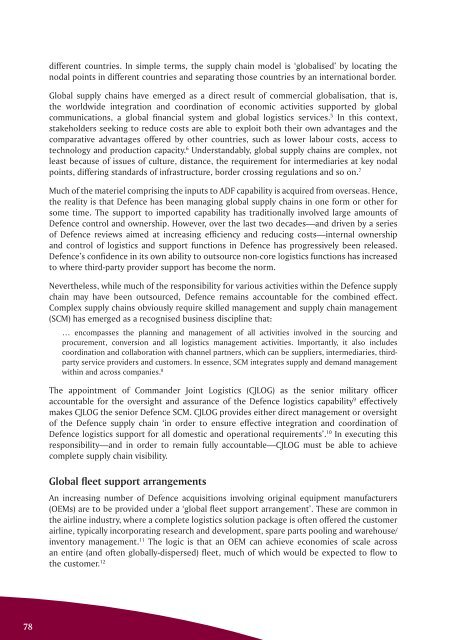ISSUE 183 : Nov/Dec - 2010 - Australian Defence Force Journal
ISSUE 183 : Nov/Dec - 2010 - Australian Defence Force Journal
ISSUE 183 : Nov/Dec - 2010 - Australian Defence Force Journal
You also want an ePaper? Increase the reach of your titles
YUMPU automatically turns print PDFs into web optimized ePapers that Google loves.
different countries. In simple terms, the supply chain model is ‘globalised’ by locating thenodal points in different countries and separating those countries by an international border.Global supply chains have emerged as a direct result of commercial globalisation, that is,the worldwide integration and coordination of economic activities supported by globalcommunications, a global financial system and global logistics services. 5 In this context,stakeholders seeking to reduce costs are able to exploit both their own advantages and thecomparative advantages offered by other countries, such as lower labour costs, access totechnology and production capacity. 6 Understandably, global supply chains are complex, notleast because of issues of culture, distance, the requirement for intermediaries at key nodalpoints, differing standards of infrastructure, border crossing regulations and so on. 7Much of the materiel comprising the inputs to ADF capability is acquired from overseas. Hence,the reality is that <strong>Defence</strong> has been managing global supply chains in one form or other forsome time. The support to imported capability has traditionally involved large amounts of<strong>Defence</strong> control and ownership. However, over the last two decades—and driven by a seriesof <strong>Defence</strong> reviews aimed at increasing efficiency and reducing costs—internal ownershipand control of logistics and support functions in <strong>Defence</strong> has progressively been released.<strong>Defence</strong>’s confidence in its own ability to outsource non-core logistics functions has increasedto where third-party provider support has become the norm.Nevertheless, while much of the responsibility for various activities within the <strong>Defence</strong> supplychain may have been outsourced, <strong>Defence</strong> remains accountable for the combined effect.Complex supply chains obviously require skilled management and supply chain management(SCM) has emerged as a recognised business discipline that:… encompasses the planning and management of all activities involved in the sourcing andprocurement, conversion and all logistics management activities. Importantly, it also includescoordination and collaboration with channel partners, which can be suppliers, intermediaries, thirdpartyservice providers and customers. In essence, SCM integrates supply and demand managementwithin and across companies. 8The appointment of Commander Joint Logistics (CJLOG) as the senior military officeraccountable for the oversight and assurance of the <strong>Defence</strong> logistics capability 9 effectivelymakes CJLOG the senior <strong>Defence</strong> SCM. CJLOG provides either direct management or oversightof the <strong>Defence</strong> supply chain ‘in order to ensure effective integration and coordination of<strong>Defence</strong> logistics support for all domestic and operational requirements’. 10 In executing thisresponsibility—and in order to remain fully accountable—CJLOG must be able to achievecomplete supply chain visibility.Global fleet support arrangementsAn increasing number of <strong>Defence</strong> acquisitions involving original equipment manufacturers(OEMs) are to be provided under a ‘global fleet support arrangement’. These are common inthe airline industry, where a complete logistics solution package is often offered the customerairline, typically incorporating research and development, spare parts pooling and warehouse/inventory management. 11 The logic is that an OEM can achieve economies of scale acrossan entire (and often globally-dispersed) fleet, much of which would be expected to flow tothe customer. 1278
















